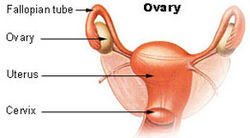 Another community of microbes found in humans in areas once thought to be sterile (without bacteria) - the ovaries and fallopian tubes in the female upper reproductive tract. And the interesting thing is that once again we see differences in the bacterial communities of areas with and without cancer (here the ovaries). From Science Daily:
Another community of microbes found in humans in areas once thought to be sterile (without bacteria) - the ovaries and fallopian tubes in the female upper reproductive tract. And the interesting thing is that once again we see differences in the bacterial communities of areas with and without cancer (here the ovaries). From Science Daily:
Bacteria found in female upper reproductive tract, once thought sterile
They're inside our gut, on the skin, and in the mouth. Thousands of different types of micro-organisms live in and on the body, playing helpful roles in digestion or in aiding the body's natural defense system. Now, scientists at the University of North Carolina Lineberger Comprehensive Cancer Center have found tiny organisms living in the upper female reproductive tract, an environment they said was once thought to be sterile.
In a preliminary finding (abstract 5568) presented Monday, June 6, at the 2016 American Society of Clinical Oncology Annual Meeting in Chicago, researchers revealed they have found bacteria in the ovaries and in the fallopian tubes. And with an additional finding that women with ovarian cancer have a different bacterial makeup, researchers are asking whether these tiny organisms could play a role in cancer development or progression.
To test whether there were bacteria in the upper female reproductive tract, researchers gathered samples from 25 women with and without cancer who were undergoing surgery to either have their uterus, fallopian tubes, or ovaries removed. The researchers then used genetic sequencing to determine what types of bacteria were present....Genetics-based approaches to identifying bacteria have made studies like theirs possible, Keku said, as some bacteria cannot be grown outside of the body in the laboratory.
From their analysis, the researchers found different types of bacteria in the fallopian tube and ovary. They also found differences in the types of bacteria in the upper reproductive tracts of women with and without epithelial ovarian cancer. Keku said the bacterial strains in the women with ovarian cancer were more pathogenic. The findings were borderline statistically significant, which the researchers said suggested a trend.
While they said it's too early to tell if the bacterial differences play a role in cancer development, researchers said their proof-of-concept study is a step needed to answer that question. Further studies are needed to determine if changes in the type of bacteria and other organisms in those regions come before the development of cancer.
 Human female ovary and Fallopian tube. Credit: Wikipedia
Human female ovary and Fallopian tube. Credit: Wikipedia
